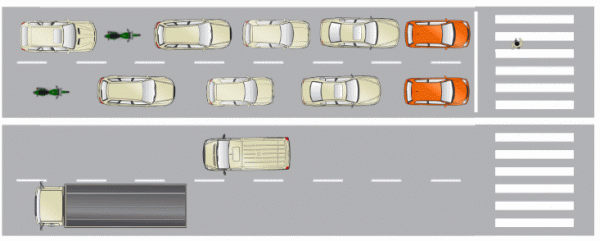Traffic ahead of you can stop temporarily for a number of reasons: a pedestrian crossing, a junction, an intersection, some traffic lights or simply because of peak hour congestion.
You’ll see that some people will stop really close to the vehicle in front while others leave a huge gap. Exactly how much space should you leave?
The advice a driving instructor is likely to give you is “tyres and tarmac”. This means that you stop your vehicle where you can still see the tyes from the vehicle in front of you touching the tarmac. The actual distance will vary depending on what kind of vehicle you are driving and how short or tall you are, but the basic concept is to leave a safety buffer. Leaving a good sized space to the vehicle in front:
- Allows you room to pull out and around the vehicle if it stalls or breaks down
- Enables you to see further up the road (the closer you are to the vehicle in front, the more it blocks your view ahead)
- Gives you a buffer in case someone hits you from the rear – you’re less likely to be pushed into the vehicle in front which means less overall inconvenience and damage, and if you see it about to happen you can always move forward a bit to give them more space to stop in.
- Leaves a space for filtering motorcycles and cycles to use (motorcycles especially are likely to be quicker than other vehicles, so there’s no point in holding them up)
- Gives you a buffer if the vehicle in front rolls back towards you if you are facing uphill
- Allows pedestrians to cross between the vehicles (not that this is necessarily the safest thing to do for them)
- Means less fumes get into your vehicle or helmet
- Gives you more margin for error because you will start slowing down earlier; this is important on a motorbike where hitting a patch of slippery oil might mean you need slightly longer to stop.
There are a couple of situations where stopping this far from the vehicle in front is less necessary, and could be counterproductive. Consider rush hour traffic. In the diagram below we’ve got two lanes of traffic waiting at a zebra crossing. The left-hand lane’s traffic has bunched up, and the right-hand lane is using the ‘tyres on the tarmac’ rule. For every six vehicles in the left-hand lane you can only fit five in the right-hand lane (note the position of the green motorbike).

Now imagine this scenario being every set of traffic lights in peak hour, and you can see how much less traffic can fit on the road which leads to greater congestion. As traffic moves away, there is more ground to cover by each vehicle therefore less traffic can pass through each green phase the lights. Traffic light systems are designed to shuffle packets of traffic forwards through a roading network, and the less individual vehicles you fit in each packet of traffic, the more packets need to be moved, leading to longer waiting times for vehicles.
Pollution and fuel consumption is increased by leaving a larger gap: drivers have to stop sooner rather than coasting that little bit further, and because less traffic fits on the road, rush hour is extended and everyone’s journey takes longer.
Of course, there are other risks by stopping closer – minor nose-to-tail accidents can also cause congestion. However, if you look at traffic in any major city it generally tends to bunch up, and leaving a larger gap would not improve traffic flow.
While you shouldn’t have your bonnet touching the bumper of the vehicle in front, if the traffic is stop/start because of congestion, if you are not driving uphill, and you are not following a vehicle producing a lot of fumes, stopping closer than the point of ‘tyres and tarmac’ could have benefits for all drivers around you.
In all other situations, though, it’s safest for you to use the tyres and tarmac rule.
